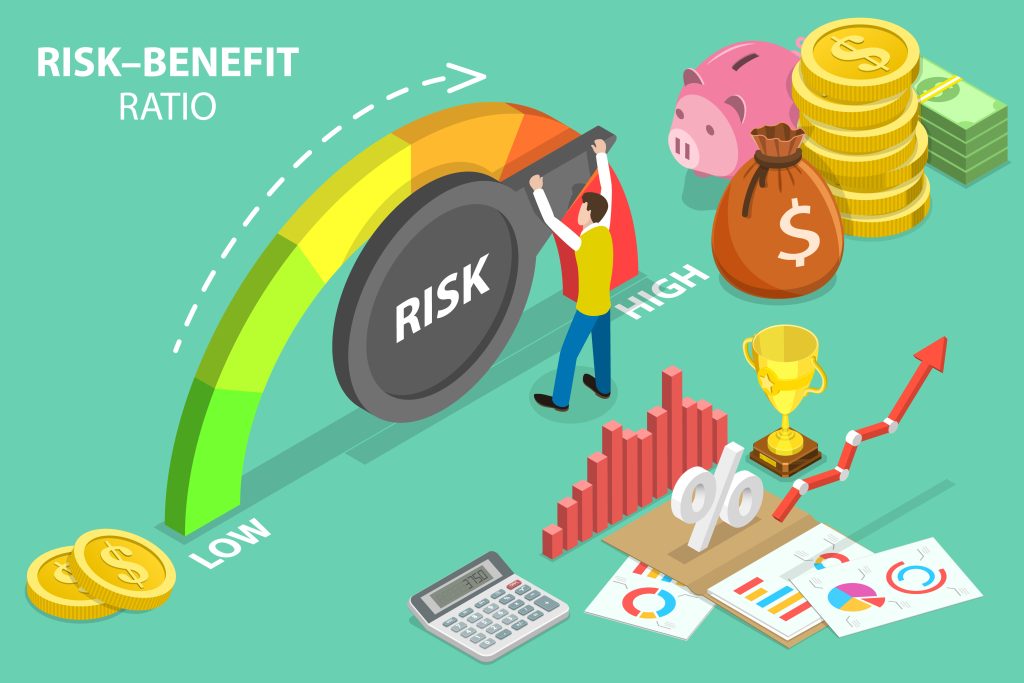THE WHY
Understanding the why guides the how when we’re building an investment plan.
Many people just like us turn to the “markets” to invest for retirement or other life events. But unlike the banking world where deposits are guaranteed, the value of stocks, bonds, mutual funds and other investments fluctuate with market conditions. There is no guarantee that you will make money on your investments, and they may lose value.
For these reasons it is important to understand the basics so you can make informed decisions. Those decisions will have a substantial impact on your retirement.
There are plenty of articles, viewpoints, strategies and ideas on how one should invest. Let’s take a step back and review the basics of investing so we can build a successful portfolio.

Historically stocks have out preformed cash and fixed income investments over an extended period of time. Short-term investments in stocks and equities are not recommended.
THE PURPOSE & AIM OF INVESTING
Make your money work for you!
The main purpose of investing is to have our money work for us. How and where we put our money to work determines how much we make on our money. The how and where decisions must match how long it will be until we need the money back.
The agony of inflation.
We are all too familiar with inflation!
Inflation is the increase in the price of goods and services. For example, if inflation is 5% then what we purchased a year ago for $1.00 will now cost $1.05. When we are planning for retirement or other future events we have to consider inflation. The agony is trying to estimate what it will be over our working career and through retirement.
There is no silver bullet to determine what inflation will be in the future. Alternatively, we rely on forecasts by economists and their computer modeling, built on historical data that predicts future expectations. However sophisticated the process may seem, Fed chair Jerome Powell has referred to it as “navigating by the stars under cloudy skies”.
These forecasts play a critical role when making investment decisions, but they are not precise.
Aim for tomorrow!
Another aim of investing is to overcome the impact of inflation.
We refer to this as the real rate of return, or the return that exceeds inflation. For instance, if inflation stands at 2% and our investments are projected to yield 5%, the real rate of return is 3% (5% – 2%). It’s how much we get to keep after inflation takes its bite.
Another way of thinking of it is inflation is as a headwind. To overcome a headwind (inflation) the force (the return on our investment) must be greater than the headwind. Another example, the propulsion of a jet engine must be greater than the headwind or the jet will stall out. Not a good outcome! Investing is no different.
THREE BASIC TYPES OF INVESTMENTS
It is important for us to have a conversational knowledge of key investment terms. Broadly speaking, we can categorize all investments into one of three categories.
- Cash
- Fixed Income
- Equities / Stocks

Cash
Cash is the simplest, most widely accepted and reliable form of money. It can be in physical form, such as currency notes (U.S. dollars in any denomination, i.e. $1, $5, $100, etc.), or in a digital form such as bank accounts, electronic payments, etc.
Cash is highly valuable because it is always liquid, meaning it is already in cash. It doesn’t have to be converted to cash to meet our immediate needs.

Fixed Income
Fixed income refers to a type of investment that provides a fixed stream of income to investors over some period. For example, you borrow $9,000 from the bank and agree to pay them back at 10% interest over 3 years. The bank’s fixed income comes from the fixed rate of interest they earn over the 3 years.
Essentially, fixed-income investments are loans that investors make to borrowers.
Companies issue bonds as a form of debt which is a type of fixed-income. It is a way for companies to borrow money from the public and pay interest on the borrowed amount. When an investor buys a corporate bond they are essentially lending money to the company in return for regular interest payments. The company will repay the principal borrowed at the end of the note. If you have had a mortgage you get the concept. Bonds and mortgages are very similar.

Equities / Stock Market
Equities and stocks are interchangeable terms and refer to ownership in a company. This means you have ownership of the company if you own its stock. If the company does well then the value of your stock should do well, but that is not always the case.
The stock market simply functions as a marketplace where sellers auction off shares of a company to the highest bidder. The marketplace determines the price of a stock on any given day based on the number of sellers and buyers. The financial performance of the company on any given day may not be reflected in the stock price today, but it eventually will.
For example, if the stock price of Walmart drops from $60 to $58 on the stock exchange, is it still a good investment? Probably so if there has not been a fundamental change in the company. It just means there were more sellers of the stock than buyers, and the price kept dropping until there were enough willing buyers to buy all the shares listed for sale.
RISK, IT’S WHAT’S FOR DINNER
All investments, including cash, have risk! With a basic understanding of risk we can transform it from foe to friend. Let’s explore it in each of the three basic types of investments.

Cash
The biggest advantage of cash is that the value doesn’t change – a $1 in the bank today will be $1 tomorrow and we can withdraw it at any time to meet our immediate cash needs.
The single biggest risk of holding cash is its inability to keep up with inflation. For example, let’s say a year ago we could buy 10 pounds of rice $9.82. With inflation at 5%, our $9.82 would only buy 9.5 pounds today.
We can offset some of the impact of inflation by investing our cash in an interest-bearing account. But, since we have the option of withdrawing the cash at will, the bank will not pay much. They can’t invest the cash deposits long-term because they have to keep it liquid in the event we want to make a withdrawal. For this reason, it is very important to have a good idea of how much cash we may need in the next 12 months. What we don’t need over the next 12 months can be tied up longer to get a higher return, helping offset inflation.
Fixed Income
Bonds and other fixed-income investments are essentially loans. Most fixed-income investments come due after a specified number of years.
- Short-term bond: 1 to 3 years
- Intermediate-term bond: 3.5 to 6 years
- Long-term bond: 6 years +
If we invest $1,000 in a 5% 6 year Walmart bond when it is originally issued, then we expect to get $50 a year in interest over the 6 years, plus our original $1,000 back at the end of the 6 years. This is holding the bond to maturity.
But what happens if we want to sell our Walmart bond before it matures in the sixth year? Instead of getting back the $1,000 we originally invested, the liquidation value is based on current interest rates. We would get $905 if current interest rates are 7%, and $1,108 if interest rates had dropped to 3%. This is the risk of investing in bonds.
The key take-away here is that if interest rates go up the value of bonds goes down. The longer the term of the bond (1, 3, 6 years, etc.), the more sensitive they are to changes in interest rates. For this reason it is important to match the length of the bond to when we think we will need those funds back.
Equities / Stocks
When we buy stocks we have equity ownership in a company, which means more risk. If the company goes bankrupt, then we lose our entire investment. But, if the company does well, can increase sales and make a profit, then we would expect to share in their success. When this occurs, more investors would desire ownership of the company and bid up the price of the stock in the marketplace (stock exchange).
Assuming the company doesn’t go bankrupt, we accept the fact that the value of all stocks will fluctuate.
All things being equal, if we have to sell our stocks to raise cash for immediate needs, then there is substantial risk our stocks will be worth less than what we paid for them. If we can plan, better estimate our immediate and future cash needs, we can choose the time to sell, improving our chances of making a profit when we sell our stock.
It is important to note that over short periods we will experience more ups-and-downs and potentially larger losses. The chance of losing money diminishes as our time frame expands. For example, since 1929, 94% of the 10-year periods in the U.S. stock market have been positive.
SUMMING IT ALL UP
Our money needs to work as hard for us as we do for it. If we realize there are risks, but more importantly, that we can manage risk it will set us up for investing success.
The most critical decision is estimating how much you need to have set aside for immediate cash needs and the timing of future cash needs.
If you are over 10 years from retirement, there may not be an immediate cash need. Over 1 year from retirement, but less than 10, we need to plan out the incremental cash needs. Those needs will drive the allocation of our investments between cash, fixed-income and equities/stocks.
Disclaimer: This article is intended to be educational only and not specific investment advice. All investors should consider their unique circumstances and risks while making investment decisions.
